Small overlap front: driver-side
Rating applies to 2013-14 models built after April 2013
Tested vehicle: 2013 Toyota RAV4 LE 4-door 4wd
The Toyota RAV4 was redesigned for the 2013 model year. Beginning with 2013 models built after April 2013, Toyota made additional changes to better control the stability of the steering column and to provide extra padding under the footwell carpeting (note: information about when a specific vehicle was manufactured is on the certification label typically affixed to the car on or near the driver door). The changes, however, weren’t enough to lift the RAV4’s performance in the small overlap frontal test.
| Evaluation criteria | Rating |
|---|---|
| Structure and safety cage | |
| Driver injury measures | |
| Head/neck | |
| Chest | |
| Hip/thigh | |
| Lower leg/foot | |
| Driver restraints and dummy kinematics The dummy’s head barely contacted the frontal airbag before sliding off the left side as the steering column moved 19 cm to the right, resulting in little airbag cushioning for the chest. Additionally, the seat belt allowed excessive forward excursion of the dummy’s head and torso, contributing to the head hitting the instrument panel. The side curtain airbag deployed and had sufficient forward coverage to protect the head from contact with side structure and outside objects. The side torso airbag also deployed. | |
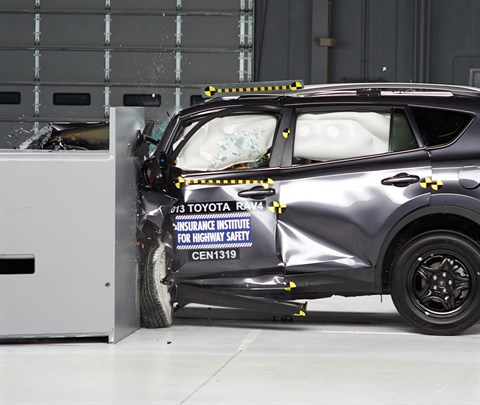
Action shot taken during the driver-side small overlap frontal crash test.
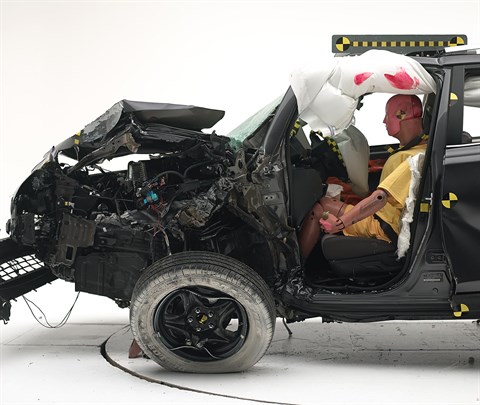
The dummy's position in relation to the door frame, steering wheel, and instrument panel after the crash test indicates that the driver's survival space wasn't maintained well.

During the crash, the dummy's head barely contacted the airbag before sliding off to the left as the steering column moved to the right. The seat belt allowed the dummy to move too far forward, as is evident from the gap between the seat back and the dummy's torso.
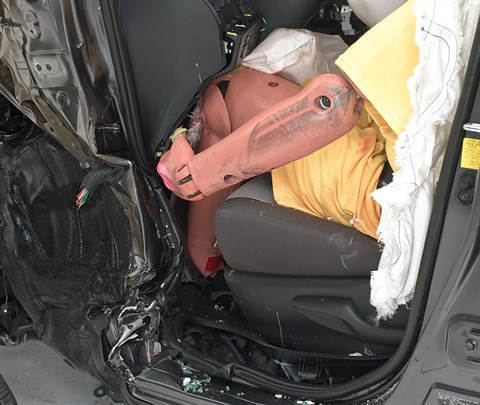
Extensive intrusion of the door hinge pillar and instrument panel contributed to a high risk of injury to the left lower leg. The dummy's left foot was trapped by the intruding structure.
Small overlap front: passenger-side
Rating applies to 2013-18 models
Tested vehicle: 2015 Toyota RAV4 LE 4-door 4wd
The Toyota RAV4 was redesigned for the 2013 model year. Although Toyota reinforced the structure in later model years on the driver side to improve occupant protection in small overlap frontal crashes, no such changes were made on the passenger side.
| Evaluation criteria | Rating |
|---|---|
| Overall evaluation | |
| Structure and safety cage | |
| Passenger injury measures | |
| Head/neck | |
| Chest | |
| Hip/thigh | |
| Lower leg/foot | |
| Passenger restraints and dummy kinematics The passenger door opened during the crash, which shouldn't happen because the driver could be partly or completely ejected from the vehicle. Still, the dummy’s head loaded the frontal airbag, which stayed in front of the dummy until rebound. The side curtain airbag deployed and has sufficient forward coverage to protect the head from contact with side structure and outside objects. The side torso airbag also deployed. | |
| Driver injury measures | |
| Head/neck | |
| Chest | |
| Hip/thigh | |
| Lower leg/foot | |
| Driver restraints and dummy kinematics | |

Action shot taken during the passenger-side small overlap frontal crash test.
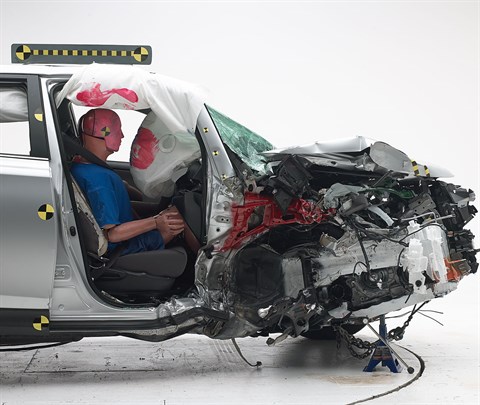
The dummy's position in relation to the door frame and dashboard after the crash test indicates that the passenger's survival space was not maintained well.

The frontal and side curtain airbags worked well together to keep the head from coming close to any stiff structure or outside objects that could cause injury.

Despite extensive intrusion of the door hinge pillar and dashboard, risk of injury was moderate and limited to both lower legs.
Moderate overlap front: original test
Rating applies to 2013-18 models
Tested vehicle: 2013 Toyota Rav4 LE 4-door 4wd
The Toyota RAV4 was redesigned for the 2013 model year. Moderate overlap frontal ratings are assigned by the Institute based on a test conducted by Toyota.
| Evaluation criteria | Rating |
|---|---|
| Overall evaluation | |
| Structure and safety cage | |
| Driver injury measures | |
| Head/neck | |
| Chest | |
| Leg/foot, left | |
| Leg/foot, right | |
| Driver restraints and dummy kinematics | |
Side: original test
Rating applies to 2013-18 models
Tested vehicle: 2013 Toyota RAV4 LE 4-door 4wd with standard front and rear head curtain airbags and standard front seat-mounted torso airbags
The Toyota RAV4 was redesigned for the 2013 model year. Two side tests of the RAV4 were conducted, one by the Institute and the other by Toyota. Ratings are based on both tests.
| Evaluation criteria | Rating |
|---|---|
| Overall evaluation | |
| Structure and safety cage | |
| Driver injury measures | |
| Head/neck | |
| Torso | |
| Pelvis/leg | |
| Driver head protection | |
| Rear passenger injury measures | |
| Head/neck | |
| Torso | |
| Pelvis/leg | |
| Rear passenger head protection | |

View of the vehicle and barrier just after the Institute's crash test.
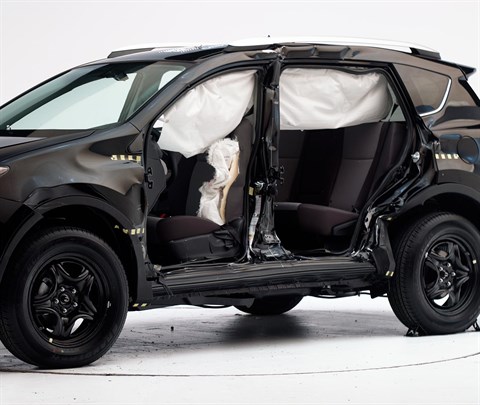
View of the vehicle after the crash with doors removed, showing the side airbags and damage to the occupant compartment (Institute test car shown).

Smeared greasepaint shows where the driver dummy's head was protected from being hit by hard structures by the side curtain airbag in the Institute's test.
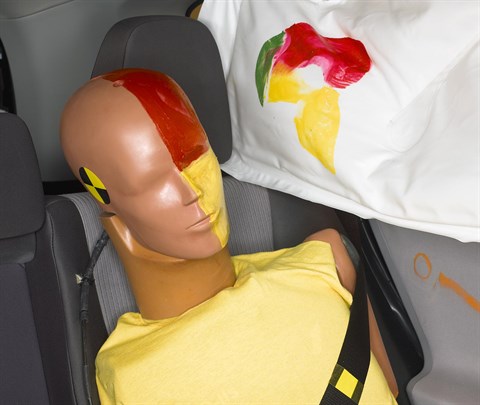
Smeared greasepaint shows where the rear passenger dummy’s head was protected by the side airbag.
Roof strength
Rating applies to 2013-18 models
Tested vehicle: 2013 Toyota RAV4 LE 4-door 4wd
| Overall evaluation | |
|---|---|
| Curb weight | 3,516 lbs |
| Peak force | 17,575 lbs |
| Strength-to-weight ratio | 5.00 |
Head restraints & seats
Seat type: Manual cloth seats
| Overall evaluation | |
|---|---|
| Dynamic rating | |
| Seat/head restraint geometry |
About the head restraint & seat test
Currently, IIHS tests apply only to front seats.
